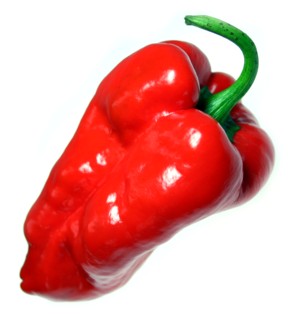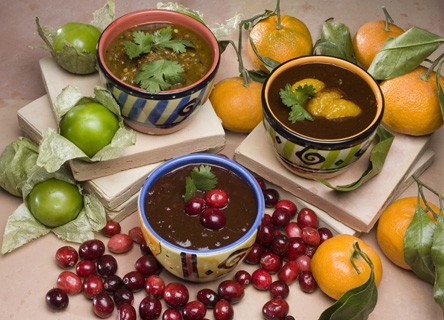Creating a Cuisine, by Dave DeWitt
The arrival of the Spanish in Mexico had a profound effect on the cuisine of the country as the ingredients the explorers brought with them soon transformed the eating habits of the Indians. However, the Aztecs and their descendants did not give up their beloved staples such as chiles, corn, and chocolate; they combined them with the new imports and thus created the basis for the Mexican cuisines of today.
Throughout the centuries, an astonishing variety in Mexican cooking developed as a result of geography. From the Yucatán Peninsula, Mexico stretches more than two thousand miles to the deserts of the north, so the length and size of Mexico, combined with the fact that mountain ranges separate the various regions, led to the development of isolated regional cuisines. This geographical variety is the reason that the cooking of tropical Yucatán differs significantly from that of the deserts of Chihuahua and Sonora.
 One common factor, though, in Mexican cookery is the prevalence of chile peppers. Unlike South America, where chiles are still mostly consumed by the Indian population, in Mexico everyone fell in love with the pungent pods. Chile peppers are Mexico’s most important vegetable crop; they are grown all over the country from the Pacific and Gulf Coasts to mountainous regions with an altitude above 8,000 feet. Approximately 200,000 acres of cultivated land produce between 500,000 and 650,000 tons of fresh pods and
One common factor, though, in Mexican cookery is the prevalence of chile peppers. Unlike South America, where chiles are still mostly consumed by the Indian population, in Mexico everyone fell in love with the pungent pods. Chile peppers are Mexico’s most important vegetable crop; they are grown all over the country from the Pacific and Gulf Coasts to mountainous regions with an altitude above 8,000 feet. Approximately 200,000 acres of cultivated land produce between 500,000 and 650,000 tons of fresh pods and  30,000 tons of dry pods, making Mexico number six of the chile-producing countries of the world. Although more than thirty different varieties are grown or collected in Mexico, the anchos/poblanos, serranos, mirasols, and jalapeños account for seventy-five percent of the crop. In 1988, Mexico exported 2,529 metric tons of fresh or dried chiles worth $4.6 million into the United States.
30,000 tons of dry pods, making Mexico number six of the chile-producing countries of the world. Although more than thirty different varieties are grown or collected in Mexico, the anchos/poblanos, serranos, mirasols, and jalapeños account for seventy-five percent of the crop. In 1988, Mexico exported 2,529 metric tons of fresh or dried chiles worth $4.6 million into the United States.
In 1985, each Mexican consumed about fourteen pounds of green chile and nearly two pounds of dried chile. In fact, the Mexicans eat more chile per capita than onions or tomatoes. The favorite chiles are about evenly divided between those harvested fresh and those utilized in the dry form.
The serranos and jalapeños are grown for processing and the fresh market, where they are the chiles of choice for salsas. Over ninety percent of the Serrano crop is used fresh in homemade salsas such as our version of Pico de Gallo, which is known by quite a few other names. Serranos are also used in a popular cooked sauce, Tomatillo Sauce.
About sixty percent of the jalapeño crop is processed, either by canning or pickling or as commercial salsas. Of the remainder, twenty percent is used fresh and twenty percent is used in the production of chipotles, the smoked and dried form of the jalapeño.
How Many Moles?
Perhaps the most famous Mexican chile dishes are the moles. The word mole, from the Náhuatl molli, means “mixture,” as in guacamole, a mixture of vegetables (guaca). Some sources say that the word is taken from the Spanish verb moler, meaning to grind. Whatever its precise origin, the word used by itself embraces a vast number of sauces utilizing every imaginable combination of meats, vegetables, spices, and flavorings–sometimes up to three dozen different ingredients. Not only are there many ingredients, there are dozens of variations on mole–red moles, green moles, brown moles, fiery moles, and even mild moles.
 The earliest moles were simple compared with what was to come after the Spanish invasion. Ana M. de Benítez, who reconstructed pre-Columbian dishes based on de Sahagún’s descriptions, used four different chiles (ancho, mulato, pasilla, and chipotle), plus tomatoes, garlic, pumpkins, tomatillos, and chayote as the basis of her moles. The addition of Eastern Hemisphere ingredients such as almonds, raisins, garlic, cinnamon, and cloves would eventually transform the basic mole of the Aztecs into a true delicacy.
The earliest moles were simple compared with what was to come after the Spanish invasion. Ana M. de Benítez, who reconstructed pre-Columbian dishes based on de Sahagún’s descriptions, used four different chiles (ancho, mulato, pasilla, and chipotle), plus tomatoes, garlic, pumpkins, tomatillos, and chayote as the basis of her moles. The addition of Eastern Hemisphere ingredients such as almonds, raisins, garlic, cinnamon, and cloves would eventually transform the basic mole of the Aztecs into a true delicacy.
Mole poblano, originally called mole de olores (“fragrant mole”), is the sauce traditionally served on special occasions such as Christmas that combines chiles and chocolate, a popular and revered food of the Aztecs. Moctezuma’s court consumed fifty jugs of chile-laced hot chocolate a day, and warriors drank it to soothe their nerves before going into battle. However, the story of how chocolate was combined with chile sauces does not involve warriors, but rather nuns.
Legend holds that mole poblano was invented in the sixteenth century by the nuns of the convent of Santa Rosa in the city of Puebla. It seems that the archbishop was coming to visit, and the nuns were worried because they had no food elegant enough to serve someone of his eminence. So, they prayed for guidance and one of the nuns had a vision. She directed that everyone in the convent should begin chopping and grinding everything edible they could find in the kitchen. Into a pot went chiles, tomatoes, nuts, sugar, tortillas, bananas, raisins, garlic, avocados, and dozens of herbs and spices. The final ingredient was the magic one: chocolate. The chocolate, they reasoned, would smooth the flavor of the sauce by slighly cutting its heat. Then the nuns slaughtered their only turkey and served it with the mole sauce to the archbishop, who declared it the finest dish he had ever tasted.
This is a great legend, but a more likely scenario holds that the basic mole of the Aztecs was gradually transformed by a collision of cuisines. Regarding the use of chocolate, since that delicacy was reserved for Aztec royalty, the military nobility, and religious officials, perhaps Aztec serving girls at the convent gave a royal recipe to the nuns so they could honor their royalty, the archbishop. At any rate, the recipe for mole poblano was rescued from oblivion and became a holiday favorite. De Benítez noted: “In the book on Puebla cooking, published in Puebla in 1877, we find recipes for making forty-four kinds of mole; there are also sixteen kinds of manchamanteles (tablecloth stainers) which are dishes with different kinds of chiles.”
In Mexico today, cooks who specialize in moles are termed moleros, and they even have their own competition, the National Mole Fair held every year in October at the town of San Pedro Atocpan, just south of Mexico City. At the fair, thousands of people sample hundreds of different moles created by restaurateurs and mole wholesalers. This fair is the Mexican equivalent of chili con carne cookoffs in the United States; the moleros take great pride in their fiery creations and consider each mole a work of art in the same way that chili cookoff chefs regard their chili con carne. Often the preparation of a family mole recipe takes as long as three days. Their recipes are family secrets not to be revealed to others under any circumstances; indeed, they are passed down from generation to generation.
“If one of my children wants to carry on my business as a molero and is serious about it,” molero Villa Suarez told reporter William Stockton, I will tell them all the secrets when the time comes.” But he went on to indicate that if his children were not interested in becoming moleros, his secrets would die with him.
In 1963 a group of moleros formed a mole cooperative of sixty partners who banded together for the good of their craft. They shared equipment such as pulverizers and mills, and eventually organized a fair exclusively dedicated to mole, so they formed the Feria Nacional del Mole, the National Mole Fair, held in conjunction with the fairs of the local pueblos.
By 1982, the fair had grown so large that the committee moved the location and the date to accomodate all the visitors. The mole fair became a national event and was eventually placed on the Secretary of Tourism’s calendar of fairs and fiestas. Each year bigger and better events were presented. As a result, restaurants began featuring more mole specials and tourists had more opportunities to experience the various moles. The National Mole Fair has certainly become one of the premier chile pepper events in the world.




